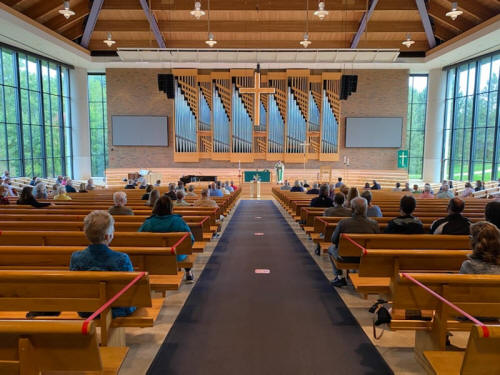|
Builder: Schantz Organ Co (2001) Originally Casavant Freres Opus 1177 (1927) Manuals: 4 Ranks: 108 Pipes: 7310 Action: Electro-pneumatic Notes: Mixtures have a console switch to turn off the tierce GREAT: 16' Double Open Diapason 73 16' Bourdon 73 8' First Open Diapason 73 8' Second Open Diapason 73 8' Hohl Flute 73 8' Bourdon 73 8' Gemshorn 73 4' Octave 73 4' Principal (from Cornet) 4' Harmonic Flute 73 2-2/3' Twelfth 73 2' Fifteenth 61 8' Cornet V 365 (1-8-12-15-17) 2' Fourniture 292 (15-17-19-22) 16' Contra Tromba 73 (10") 8' Tromba 73 (10") 4' Clarion 73 (10") 16' Trompette en Chamade (ext) 8' Trompette en Chamade 61 (10") new Chimes (solo) Celesta (Choir) MIDI on Great SWELL: 16' Bourdon 73 8' Open Diapason 73 8' Geigen Principal 73 8' Flute Traverse 73 8' Cor de Nuit 73 8' Viola da Gamba 73 8' Voix Celeste 73 8' Dolcissimo 73 8' Dolcissimo Celeste 73 (from Casavant 1250) 4' Octave 73 4' Flute Octaviante 73 4' Violina 73 2' Piccolo 61 8' Cornet 365 2' Plein Jeu IV 292 (15-17-19-22) 16' Double Trumpet 73 (10") 8' Cornopean 73 (10") 8' Oboe 73 (10") 8' Vox Humana 73 (10") 4' Clarion 73 (10") Tremulant 8' Trompette en Chamade (Gt) Chimes (Choir) Celesta (Solo) MIDI on SwellCHOIR: 16' Quintaton 73 8' Open Diapason 73 8' Melodia 73 8' Rohr Flute 73 8' Quintadena 73 8' Viole d'Orchestre 73 8' Viole Celeste 73 8' Dulciana 73 8' Unda Maris 73 (from Casavant 1250) 4' Octave 73 4' Flute d'Amour 73 2-2/3' Nasard 73 2' Flageolet 61 1-3/5' Tierce 61 1-1/3' Petit Quint 61 1-1/7' Septieme 61 1' Piccolo 61 Cornet VIII (derived) 16' Bassoon 73 (10") 8' Trumpet 73 (10") 8' Clarinet 73 (10") 8' Trompette en Chamade (Great) Celesta (Solo) Harp (Solo) Chimes (Solo) Tremulant MIDI on ChoirSOLO: 16' Contra Gamba 73 8' Diapason 73 8' Grosse Flute 73 8' Gamba 73 8' Gamba Celeste 73 4' Octave 73 4' Flute Octaviante 73 4' Viola 73 2' Piccolo (from Cornet) 4' Grand Cornet VII 511 (8-10-12-15-17-19-22) 16' Tuba Magna 73 (20") 8' Tuba Mirabilis 73 (20") 8' French Horn 73 (20") 8' Cor Anglais 73 (20") 4' Tuba Clarion 73 (20") Tremulant 16' Trompette en Chamade (Great) 8' Trompette en Chamade (Great) Chimes 25 Deagan Class A Celesta 61 MIDI on SoloPEDAL: 64' Gravissima (32' Double Open unison, 32' Soubasse quint) 32' Double Open Diapason 12 32' Soubasse 12 16' Open Diapason 56 16' Bourdon 32 16' Violone 32 16' Dulciana 32 16' Gedeckt (Swell) 10-2/3' Quint 44 8' Octave (ext) 8' Flute 32 8' Gedeckt (Swell) 8' Cello 32 8' Dulciana (ext) 6-2/5' Tierce 32 5-1/3' Quint (ext) 4' Super Octave (ext) 4' Bourdon 32 4' Gedeckt (Swell) 4' Dulciana (ext) 32' Contra Trombone 12 (10") 16' Trombone 32 (10") 16' Bassoon 32 (10") 8' Trumpet 32 (10") 4' Clarion 32 (10") 2' Octave Clarion 32 (10") 16' Tuba Magna (Solo) 16' Double Trumpet (Swell) 8' Trumpet (Swell) 8' Trompette en Chamade (Great) Chimes MIDI on Pedal The 4 manual, 108 rank Casavant organ, Op 1177 (1927) from the Phillips Academy in Andover, MA plays again in its new home after nearly two decades of silence. The organ has been reconstructed by the Schantz Organ Company of Orrville, Ohio and installed in the summer of 2001 in the new 1800 seat sanctuary of St. Andrew’s Lutheran Church in Mahtomedi, MN. Originally installed in George Washington Hall at the academy, the organ was relocated to a new chapel on the campus in 1932 when the burden of the Great Depression prohibited the purchase of a planned new instrument. In this second installation, most of the organ suffered from extremely poor tonal egress with pipes trapped behind walls and facade woodwork. Nearly doomed to become another casualty of the then fashionable “neo-” trends in American organ building, the closeted Casavant survived for almost a half century before the school decided to replace it with a smaller, well-placed instrument. The organ was sold and moved to a barn in Traverse City, MI where it was to stay temporarily before being reinstalled in a nearby performing arts building. Those plans never materialized, and the organ changed owners several times but remained in the barn and endured over 15 years of grim storage conditions. In 1995 the organ was purchased by a St. Andrew’s family and finally moved to safe storage in November of 1996. Due to the unfortunate damage from years of neglect and the care-less loss of critical components, plans for a full restoration of all the chests, console and mechanisms were abandoned. Instead, all new electro-pneumatic chests replace the original ventil chests, and the reconfigured organ includes a new console (with original ivory keys from another 1920’s Casavant) and a new facade which was installed by Schantz in the fall of 1999. Of the 7,310 pipes of the organ, almost all are restored original pipes and faithful replicas replace pipes deemed beyond repair. Notable yet somewhat typical attributes of this 1920’s Casavant include: 3-32′ pedal stops; 73-note manual chests for most stops, including mixtures and Cornets; Diapason choruses in all divisions; 16′-8′-4′ chorus reeds in each manual division; 3 amply scaled Cornets; and 9-16′ manual stops with only 1 originally borrowed to the pedal, which itself has 14 independent registers. The design architect for the new sanctuary is the Danish firm Friis & Moltke A/S; the acoustical consultant is Kirkeg
|
 |